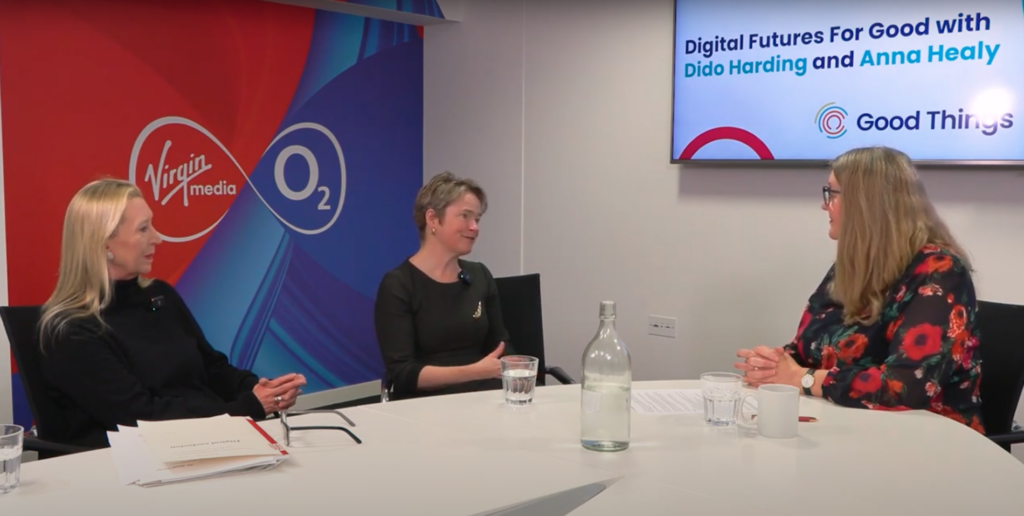Tackling the Digital Divide: Digital Futures for Good
Good Things CEO, Helen Milner, reflects on the first episode of Digital Futures For Good, where she spoke with Baroness Dido Harding and Baroness Anna Healy.
‘Digital Futures for Good’’ is an in-depth conversation series by Good Things Foundation that focuses on the transformational potential of policymaking and innovative initiatives in fixing the digital divide.
In the series’ first episode, I had the pleasure of hearing from Baroness Dido Harding and Baroness Anna Healy. Between them they have experience in business and politics spanning decades and bring together a deep understanding and commitment to digital exclusion – especially having been part of the House of Lords inquiry into the issue last year.

In thinking about their hypothetical first 100 days as Prime Minister, both Harding and Healy prioritised leadership and visibility. Harding emphasised the need for the Prime Minister to champion digital inclusion personally and spotlight its significance for various sectors — from enhancing public services to improving healthcare — and its wide-reaching impact on everyone’s lives. On the other hand, Healy highlighted the crucial role of leadership at the highest levels of government. She draws parallels between digital inclusion and social policies, such as ‘Sure Start’, the minimum wage, and campaigns against poverty, which were launched and effectively implemented thanks to clear, committed leadership. Both stressed the importance of leadership not simply endorsing policies but becoming champions; ensuring priorities across all departments.
Healy proposed a delivery unit focused on digital inclusion, supported by strong leadership with high level vision. These units were popular under Blair, but required cross-governmental support and resources to avoid operational silos—a challenge Healy acknowledges from previous government initiatives. If high-level vision is going to drive change we need a cross-government digital inclusion unit, as suggested by the Lords’ Inquiry Report, or a central executive cabinet committee, backed by the Prime Minister or influential Cabinet ministers. These could overcome budget constraints that leave certain government departments in weak positions and hinder addressing long-term, complex challenges.
Healy was right to frame digital inclusion as a national mission essential for progress in facing the grand-challenges of sluggish growth and a struggling NHS that our country faces. Digital exclusion extends beyond issues with governance and affects broader society. We know this all too well, our research with the Centre for Economic Business Research and before that for the NHS Widening Digital Participation Programme corroborates the impact of exclusion on everything from digital skills and employability to health inequity and worse health outcomes.
Critics argue that digital exclusion would be better solved through targeting poverty, but we know there is no ‘silver bullet’ for digital inclusion, every part of society must integrate digital inclusion into its strategy. Harding pointed out that critics don’t understand the dynamic nature of digital exclusion. As technology evolves, so too does the boundaries of inclusion, making digital inclusion a moving target. And inclusion is more than just access, it’s about ensuring people have the necessary capabilities to adapt and thrive as technology advances. We need a holistic and committed approach to digital inclusion.
Good Things Foundation began as UK Online Centres under the first Labour government, and has since evolved to meet the increasing need for skills and access. Although we are now looking towards AI, the need for flexible, accessible, and welcoming social infrastructure for ongoing training and education remains the same. Achieving digital inclusion requires sustained effort, innovative policies, and collaboration across government and business.
Healy’s call to action was a suggestion of a roundtable with business leaders in the initial 100 days, to get real energy and momentum with stakeholders. Despite a decade passing since the last update to the Government’s Digital Strategy, Healy remains optimistic about the potential for substantial progress and we do too. She calls for determination, commitment, and visible leadership to deliver societal progress, a sentiment I know many share in civil society.
In facing long-term and complex challenges, the UK’s governance requires a new approach. Labour has a new vision for mission-driven government which in theory promises solutions to public policy challenges of a cross-cutting nature. We think that digital inclusion is a primary test case for a government committed to cross-cutting action because it demands collective effort from all levels of government, is fairly easy to deliver, and can offer a blueprint for future government collaboration.
If you’re interested in learning more from thought-leaders about how many challenges facing people today intersect with digital exclusion, and gaining insight into what’s next for digital policy, sign up for our next Digital Futures For Good launch with Martha Lane Fox on Thursday 11 April at 1-2pm.
